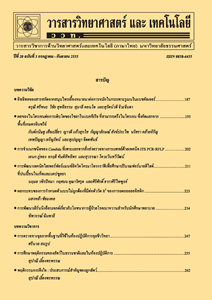การใช้ฝุ่นข้าวโพดเป็นสารเสริมในข้าวโพดหมัก
Main Article Content
Abstract
บทคัดย่อ
กระบวนการหมักลำต้นข้าวโพดอ่อนและเปลือกหุ้มฝักข้าวโพดอ่อน ร่วมกับการเติมฝุ่นข้าวโพดเป็นสารเสริมในอัตราส่วนต่าง ๆ ( 2.5, 5, 10 เปอร์เซ็นต์) เป็นเวลา 30 วัน ตรวจวัดความเป็นกรด - เบส ของลำต้นข้าวโพดอ่อนพบว่าค่าเฉลี่ยเท่ากับ 3.70 -3.78 และส่วนของเปลือกหุ้มฝักข้าวโพดอ่อนมีค่าเฉลี่ยเท่ากับ3.62-3.64 เมื่อนับชนิดของจุลินทรีย์พบแบคทีเรียมีจำนวนเพิ่มขึ้น และ เชื้อแบคทีเรียในกลุ่มแลคติดแอซิค และ เชื้อยีสต์ในส่วนของลำต้นและเปลือกหุ้มฝักข้าวโพดอ่อนมีปริมาณผันแปรตามกับปริมาณฝุ่น ข้าวโพดที่เพิ่มมากขึ้นเช่นเดียวกัน การประเมินคุณค่าทางโภชนะและการย่อยได้ในกระเพาะรูเมนโดยวิธีแบชคัลเจอร์ของข้าวโพดหมักจากต้นและใบข้าวโพดฝักอ่อน และเปลือกข้าวโพดฝักอ่อน ที่เสริมด้วยฝุ่นข้าวโพดในอัตราส่วน (0, 2.5, 5 และ 10 เปอร์เซ็นต์) พบว่า ข้าวโพดหมักจากต้นและใบข้าวโพดฝักอ่อน มีการสูญเสียน้ำหนักแห้ง (14.33%) ปริมาณน้ำหนักแห้ง (23.06%) การย่อยได้วัตถุแห้ง (56.00%) การย่อยได้อินทรียวัตถุ (54.47%) และการย่อยได้โปรตีน (70.42%) มากกว่า (P<0.05) ในข้าวโพดหมักที่ทำจากเปลือกข้าวโพดฝักอ่อน (13.18, 16.85, 54.17, 53.52 และ 67.85% ตามลำดับ)ในขณะที่ ข้าวโพดหมักจากเปลือกข้าวโพดฝักอ่อนมีอินทรียวัตถุ (94.86%) และโปรตีน (10.41%) สูงกว่า (P<0.05) ในข้าวโพดหมักจากต้นและใบข้าวโพดฝักอ่อน (93.04 และ 7.42% ตามลำดับ) แต่ปริมาณแอมโมเนียไนโตรเจน (2.38-2.44%) และค่า pH (3.61-3.65) ของข้าวโพดหมักทั้งสองชนิดไม่แตกต่างกัน (P>0.05) การเสริมฝุ่นข้าวโพดในการทำข้าวโพดหมักช่วยเพิ่มปริมาณวัตถุแห้ง และโปรตีน ลดการสูญเสียน้ำหนักแห้ง อินทรียวัตถุ แอมโมเนียไนโตรเจน การย่อยได้วัตถุแห้ง การย่อยได้อินทรียวัตถุ และการย่อยได้โปรตีน ขณะที่ค่า pH ไม่เปลี่ยนแปลง และไม่พบอิทธิพลร่วมระหว่างปัจจัยทั้งสองต่อค่าโภชนะและการย่อยได้ในกระเพาะรูเมนในแบชคัลเจอร์ที่ทำการศึกษา
คำสำคัญ : จุลินทรีย์; ต้นและใบข้าวโพดฝักอ่อน; เปลือกข้าวโพดฝักอ่อน; ฝุ่นข้าวโพด; ข้าวโพดหมัก; ค่าโภชนะ การย่อยได้ในกระเพาะรูเมน; แบชคัลเจอร์
Abstract
Process of producing corn silage from stem and leaf of baby corn and baby corn husk added with corn dust (0%, 2.5%, 5% and 10%) in batch culture had been done by fermenting for 30 days. Types and numbers of microorganism (bacteria yeast and lactic acid bacteria) and their pH were determined. It was found that the average pH from stem and leaf of baby corn (SL) were 3.70 – 3.78 and from baby corn husk (BCH) were 3.62 – 3.64. During the period of fermenting, types of microorganism were counted. The numbers of total bacteria and lactic acid bacteria were increased while the number of yeast was increased in SL and BCH when the concentration of corn dust was increase. The evaluation of nutrient values and rumen digestibility of corn silage produced from stem and leaf of baby corn and baby corn husk added with corn dust in batch culture which supplemented with corn dust (0, 2.5, 5 and 10%) was done. It was found that the corn silage produced from SL had higher (P<0.05) dry matter loss (14.33%), dry matter content (23.26%), dry matter digestibility (56%), organic matter digestibility (54.47%) and protein digestibility (70.42%) than those of the corn silage produced from BCH (13.18, 16.85, 54.17, 53.52 and 67.85%, respectively) whereas the corn silage produced from BCH had higher (P<0.05) organic matter content (94.86%) and protein (10.41%) than those of the corn silage produced from SL (93.04 and 7.42%, respectively). Ammonia nitrogen (2.38-2.44%) and pH (3.61-3.65) of both corn silages were not significantly different (P>0.05). Corn dust added to the ensilage significantly increased (P<0.05) in dry matter protein contents but significantly decreased (P<0.05) in dry matter loss, organic matter content, dry matter digestibility, organic matter digestibility and protein digestibility whereas pH remained unchanged. None of the interaction effects (P>0.05) of the types of raw material for ensilage and corn dust addition were found in all parameters measured.
Keywords: stem and leaf of baby corn; baby corn husk; corn dust; corn silage; nutrient value; digestibility in rumen; batch culture


